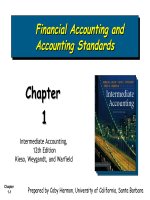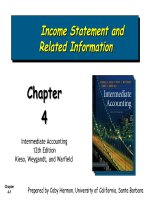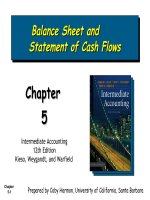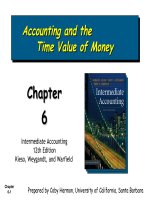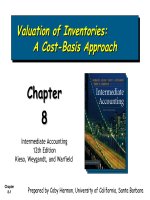Intermediate accounting 12th edition kieso warfield chapter 06
Bạn đang xem bản rút gọn của tài liệu. Xem và tải ngay bản đầy đủ của tài liệu tại đây (372.84 KB, 54 trang )
Accounting
Accounting and
and the
the
Time
Time Value
Value of
of Money
Money
Chapter
6
Intermediate Accounting
12th Edition
Kieso, Weygandt, and Warfield
Chapter
6-1
Prepared by Coby Harmon, University of California, Santa Barbara
Learning
Learning Objectives
Objectives
1.
Identify accounting topics where the time value of money
is relevant.
2.
Distinguish between simple and compound interest.
3.
Use appropriate compound interest tables.
4.
Identify variables fundamental to solving interest
problems.
5.
Solve future and present value of 1 problems.
6.
Solve future value of ordinary and annuity due problems.
7.
Solve present value of ordinary and annuity due problems.
8.
Solve present value problems related to deferred
annuities and bonds.
9.
Apply expected cash flows to present value measurement.
Chapter
6-2
Accounting
Accounting and
and the
the Time
Time Value
Value of
of Money
Money
Basic Time
Value
Concepts
Applications
The nature of
interest
Simple
interest
Compound
interest
Fundamental
variables
Chapter
6-3
Single-Sum
Problems
Future value
of a single
sum
Present value
of a single
sum
Solving for
other
unknowns
Annuities
Future value of
ordinary
annuity
Future value of
annuity due
Examples of
FV of annuity
Present value
of ordinary
annuity
Present value
of annuity due
Examples of
PV of annuity
More
Complex
Situations
Deferred
annuities
Valuation of
long-term
bonds
Effectiveinterest
method of
bond
discount/
premium
amortization
Present Value
Measurement
Expected
cash flow
illustration
Basic
Basic Time
Time Value
Value Concepts
Concepts
Time Value of Money
In accounting (and finance), the term indicates
that a dollar received today is worth more than a
dollar promised at some time in the future.
Chapter
6-4
LO 1 Identify accounting topics where the time value of money is relevant.
Basic
Basic Time
Time Value
Value Concepts
Concepts
Applications to Accounting Topics:
1. Notes
5. Sinking Funds
2. Leases
6. Business Combinations
3. Pensions and Other
7. Disclosures
Postretirement
Benefits
8. Installment Contracts
4. Long-Term Assets
Chapter
6-5
LO 1 Identify accounting topics where the time value of money is relevant.
Basic
Basic Time
Time Value
Value Concepts
Concepts
Nature of Interest
Payment for the use of money.
Excess cash received or repaid over the amount
borrowed (principal).
Variables involved in financing transaction:
1. Principal - Amount borrowed or invested.
2. Interest Rate - A percentage.
3. Time - The number of years or portion of a year
that the principal is outstanding.
Chapter
6-6
LO 1 Identify accounting topics where the time value of money is relevant.
Simple
Simple Interest
Interest
Interest computed on the principal only.
ILLUSTRATION:
On January 2, 2007, Tomalczyk borrows $20,000 for 3
years at a rate of 7% per year. Calculate the annual
interest cost.
Principal
FULL YEAR
Interest rate
$20,000
Annual interest
x
7%
$ 1,400
Federal law requires the disclosure of interest rates on an annual basis in all contracts.
Chapter
6-7
LO 2 Distinguish between simple and compound interest.
Simple
Simple Interest
Interest
ILLUSTRATION continued:
On March 31, 2007, Tomalczyk borrows $20,000 for 3
years at a rate of 7% per year. Calculate the interest
cost for the year ending December 31, 2007.
PARTIAL
YEAR
Chapter
6-8
Principal
Interest rate
Annual
interest
$20,000
x year7%
Partial
$ 1,400
Interest for 9 months
x
9/12
$ 1,050
LO 2 Distinguish between simple and compound interest.
Compound
Compound Interest
Interest
Computes interest on
the principal and
on interest earned to date (assuming interest
is left on deposit).
Compound interest is the typical interest
computation applied in business situations.
Chapter
6-9
LO 2 Distinguish between simple and compound interest.
Compound
Compound Interest
Interest
ILLUSTRATION:
On January 2, 2007, Tomalczyk borrows $20,000 for 3
years at a rate of 7% per year. Calculate the total
interest cost for all three years, assuming interest is
compounded annually.
Date
Jan. 2007
2007
2008
2009
Compound Interest
Calculation
$20,000 x 7%
$21,400 x 7%
$22,898 x 7%
Interest
$
$
Chapter
6-10
1,400
1,498
1,603
4,501
Accumulated
Balance
$
20,000
21,400
22,898
24,501
LO 2 Distinguish between simple and compound interest.
Compound
Compound Interest
Interest Tables
Tables
Five Tables in Chapter 6
Table 1 - Future Value of 1
Table 2 - Present Value of 1
Table 3 - Future Value of an Ordinary Annuity of 1
Table 4 - Present Value of an Ordinary Annuity of 1
Table 5 - Present Value of an Annuity Due of 1
Number of Periods = number of years x the number of
compounding periods per year.
Compounding Period Interest Rate = annual rate divided by
the number of compounding periods per year.
Chapter
6-11
LO 3 Use appropriate compound interest tables.
Compound
Compound Interest
Interest
Compounding can substantially affect the rate of
return. A 9% annual interest compounded daily
provides a 9.42% yield.
How compounding affects Effective Yield for a $10,000 investment.
Illustration 6-5
Chapter
6-12
LO 3 Use appropriate compound interest tables.
Compound
Compound Interest
Interest
Variables Fundamental to Compound Interest
Rate of Interest
Number of Time Periods
Present Value
Future Value
Illustration 6-6
Chapter
6-13
LO 4 Identify variables fundamental to solving interest problems.
Single-Sum
Single-Sum Problems
Problems
Generally Classified into Two Categories
Unknown Present Value
Chapter
6-14
Unknown Future Value
LO 5 Solve future and present value of 1 problems.
Single-Sum
Single-Sum Problems
Problems
Future Value of a Single Sum
Multiply the future value factor by its present
value (principal).
Illustration:
BE6-1 Steve Allen invested $10,000 today in a
fund that earns 8% compounded annually. To what
amount will the investment grow in 3 years?
Chapter
6-15
LO 5 Solve future and present value of 1 problems.
Single-Sum
Single-Sum Problems
Problems
Present Value
$10,000
0
1
Future Value?
2
3
4
5
6
BE6-1 Steve Allen invested $10,000 today in a fund
that earns 8% compounded annually. To what amount
will the investment grow in 3 years?
What table do we use?
Chapter
6-16
LO 5 Solve future and present value of 1 problems.
Single-Sum
Single-Sum Problems
Problems
Table 6-1
Number
of
Periods
2%
1
2
3
4
5
1.02000
1.04040
1.06121
1.08243
1.10408
Discount Rate
4%
6%
8%
1.04000
1.08160
1.12486
1.16986
1.21665
1.06000
1.12360
1.19102
1.26248
1.33823
1.08000
1.16640
1.25971
1.36049
1.46933
10%
1.10000
1.21000
1.33100
1.46410
1.61051
What factor do we use?
Chapter
6-17
LO 5 Solve future and present value of 1 problems.
Single-Sum
Single-Sum Problems
Problems
Table 6-1
Number
of
Periods
2%
1
2
3
4
5
1.02000
1.04040
1.06121
1.08243
1.10408
$10,000
Present Value
Chapter
6-18
Discount Rate
4%
6%
8%
x
1.04000
1.08160
1.12486
1.16986
1.21665
1.06000
1.12360
1.19102
1.26248
1.33823
1.25971
Factor
=
1.08000
1.16640
1.25971
1.36049
1.46933
10%
1.10000
1.21000
1.33100
1.46410
1.61051
$12,597
Future Value
LO 5 Solve future and present value of 1 problems.
Single-Sum
Single-Sum Problems
Problems
PROOF - Future Value of a Single Sum
Beginning
Beginning
Year
Year Balance
Balance
11
$$ 10,000
10,000
22
10,800
10,800
33
11,664
11,664
xx
xx
xx
Rate
Interest
Rate
Interest
8%
800
8% ==
800
8%
864
8% ==
864
8%
933
8% ==
933
++
++
++
Previous
Previous
Balance
Balance
10,000
10,000
10,800
10,800
11,664
11,664
==
==
==
Year-End
Year-End
Balance
Balance
$$ 10,800
10,800
11,664
11,664
12,597
12,597
BE6-1 Steve Allen invested $10,000 today in a fund
that earns 8% compounded annually. To what amount
will the investment grow in 3 years?
Chapter
6-19
LO 5 Solve future and present value of 1 problems.
Single-Sum
Single-Sum Problems
Problems
Present Value
$10,000
0
1
Future Value?
2
3
4
5
6
BE6-1 Steve Allen invested $10,000 today in a fund
that earns 8% compounded semiannually. To what
amount will the investment grow in 3 years?
What table do we use?
Chapter
6-20
LO 5 Solve future and present value of 1 problems.
Single-Sum
Single-Sum Problems
Problems
Table 6-1
Number
of
Periods
2%
1
2
3
4
5
6
1.02000
1.04040
1.06121
1.08243
1.10408
1.12616
Discount Rate
4%
6%
8%
1.04000
1.08160
1.12486
1.16986
1.21665
1.26532
What factor do we use?
Chapter
6-21
1.06000
1.12360
1.19102
1.26248
1.33823
1.41852
1.08000
1.16640
1.25971
1.36049
1.46933
1.58687
10%
1.10000
1.21000
1.33100
1.46410
1.61051
1.77156
• 6 compounding periods
• 4% interest per period
LO 5 Solve future and present value of 1 problems.
Single-Sum
Single-Sum Problems
Problems
Table 6-1
Number
of
Periods
2%
1
2
3
4
5
6
1.02000
1.04040
1.06121
1.08243
1.10408
1.12616
$10,000
Present Value
Chapter
6-22
Discount Rate
4%
6%
8%
x
1.04000
1.08160
1.12486
1.16986
1.21665
1.26532
1.06000
1.12360
1.19102
1.26248
1.33823
1.41852
1.26532
Factor
=
1.08000
1.16640
1.25971
1.36049
1.46933
1.58687
10%
1.10000
1.21000
1.33100
1.46410
1.61051
1.77156
$12,653
Future Value
LO 5 Solve future and present value of 1 problems.
Single-Sum
Single-Sum Problems
Problems
Present Value of a Single Sum
Multiply the present value factor by the future
value.
Illustration:
BE6-2 Itzak Perlman needs $20,000 in 4 years.
What amount must he invest today if his investment
earns 12% compounded annually?
Chapter
6-23
LO 5 Solve future and present value of 1 problems.
Single-Sum
Single-Sum Problems
Problems
Future Value
$20,000
Present Value?
0
1
2
3
4
5
6
BE6-2 Itzak Perlman needs $20,000 in 4 years. What
amount must he invest today if his investment earns
12% compounded annually?
What table do we use?
Chapter
6-24
LO 5 Solve future and present value of 1 problems.
Single-Sum
Single-Sum Problems
Problems
Table 6-2
Number
of
Periods
4%
2
.92456
.89000
.85734
.82645
.79719
4
.85480
.79209
.73503
.68301
.63552
6
.79031
.70496
.63017
.56447
.50663
8
.73069
.62741
.54027
.46651
.40388
Discount Rate
6%
8%
10%
12%
What factor do we use?
Chapter
6-25
LO 5 Solve future and present value of 1 problems.


